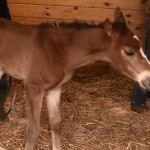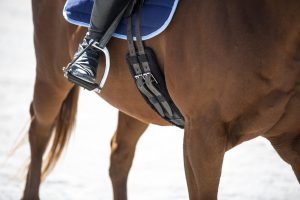Today I have something a bit different for you, and for me too! Last week I had the opportunity to work with a 10 day old foal to halter him for the first time.
I don’t do any breeding myself and rarely have the chance to play with or train a foal, so I had a lot of fun working with Lochlan.
Lochlan already seems to have a big personality, just like his dam, Fiona, who has made two blog appearances.
Take a few minutes to enjoy the video below, then leave a comment. If you have experience working with foals I would love to hear your best practices.
You can visit Lochlan’s breeder’s site (and view more pics) here: www.highlandmeadowsfarm.net














10 Responses
Sorry, but I think that was a bit more flooding than ideal for a 10 day old foal. It can be too much for foals.
Hi Rosemarie,
My intent certainly was not to flood him, and going by the definition of flooding, I would have to argue that despite any disagreement with anything I did with Lochlan, flooding was not occuring. At no time did I sense fear from him, just more of a feeling of “I’d rather not be touched there.”
By the reaction of the foal when the harness was removed- not to run, but to stand quietly for more scratches- I would have to disagree. I think we were just seeing a normal reaction to a new situation.
Awwww-thanks for sharing Callie! That was a very special moment. Love to watch your training techniques. He’s a beautiful little boy!
This is such a timely video for me! I am leasing a horse who is pregnant and due to deliver in about a month or so. It was so good to watch how you did this first haltering and to see how mom reacted to your work with her baby. I most likely won’t be doing much with the foal, as the owner (my trainer) will be responsible for him/her. I understand that some mares can get very protective of their babies and I see that your uncle was holding on to Fiona the whole time. Thanks so much for sharing this. I am so excited at the anticipated arrival of the new foal on the farm! Watching this video just made me say “Awwww…….” throughout the whole thing!
I would suggest reading Dr. Robert Miller’s book on Imprinting. The one thing I disagree upon, though, just from my own personal experience of raising and training Arabs for a dozen years or so is that Dr. Miller suggests this procedure of Imprinting be done almost immediately where I like to allow the mare and her “new foal” some time to bond…anywhere from a few hours to even one day. But this is MY personal preference). Then begin the process of exposing the foal to touching all over its body (don’t skip over any part including under tail, ears, mouth/tongue, feet) followed by moving all movable parts, bending joints, etc. Then you rub the foal with different items: towel, soft brush, plastic bag, running clippers (cordless are preferred) all over its body as well. The idea is to accustom the foal to as many objects that move and make a noise now, when its little, and surprisingly it will be much more quiet when you use things around it or pick up its feet, or give a shot, or take a temperature, etc. when its older. I also always made it a point to put a halter on the foal at 3 days old. This was a time when the foal had been touched and familiarized to humans, imprinted (when I first began raising foals I knew nothing about imprinting because the book had not yet been published.) so, at least rubbed on all over and accepting of human touch. At 3 days its not so big or strong… (As you’ll notice with Callie at just 10 days, the strength it already has). It’s amazing how quickly the foal gains strength and I just found it easier to control movement while putting the halter on…then just observing while the foal wore it a while…just sit and observe the foal getting used to wearing this “thing” on its face… for 20 minutes to an hour on (day 1). The next day I would work on leading using a “butt rope” as Callie demonstrated, but I would use the foal’s mother (being led by someone) to help teach the foal to go along behind or beside her. By one week the foal was leading pretty well ..out to pasture if available, and understood how to move forward from light pressure from the halter, but if it got stuck, I’d loop the lead rope around the foal’s butt or even use my hand and arm instead sometimes (if the foal is small enough)…whatever works for the person doing the training. Be aware that you do not want to use a long lead rope until the foal is leading pretty well and not wanting to pull back because you do NOT want the foal getting away from you dragging a long rope… in an area larger than a stall. That’s why using your arm and hand around its rump might work better for most people if the foal is small. If they are much larger than Lochlan, you could attach a short lead (just long enough to hang on to to lead from) and use another rope looped around the foal’s rump as Callie demonstrated.
Foals are such a joy and there is so much you can teach them when they’re under 6 month’s old. Clinton Anderson’s groundwork (fundamentals) will teach how to move away from pressure, be light and supple and send willingly through water, over tarps, etc. before you ride them. Then, when they are ready to back (ride), they will be halfway trained. They will have learned how to stand still while you make noises and move scary objects around and on them (blankets, bags, cans in a sack, tarps, etc.) go over, under, through, and on things…endless what you can, and should do, while they are youngsters! I hope you really enjoy this terrific and fun time! May your foal be healthy, lovely, and the perfect “horse” for you.
Fascinating and well done! It was helpful to see you staying with him regardless of his fussing. The confusion I have is if he got more and more agitated, when would be an appropriate time to stop? I wouldn’t want to stop when he was agitated, but if he was an upward spiral, I’d be afraid that staying with him would make it worse. I know I’ve made this mistake before and it turned out to be a disaster. Any thoughts?
Hi Karen,
I would probably try to go back to something easier, such as just standing next to the foal, or resting a hand on him.
Thanks for sharing Callie that was so interesting! That foal looked very relaxed and accepting of the halter at the end of the video so I think you were very successful in this session. It was amazing to watch. Thank you.
What a great little session for the new student! Thanks for sharing.